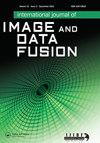利用ASTER数据绘制斑岩系统的部分亚像素和基于像素的蚀变图——以伊朗亚兹德西部为例
IF 1.8
Q3 REMOTE SENSING
International Journal of Image and Data Fusion
Pub Date : 2019-05-05
DOI:10.1080/19479832.2019.1611668
引用次数: 3
摘要
摘要本研究使用遥感图像处理来增强对具有矿物丰度晕的区域的识别,这些晕可能与亚兹德西部Urumieh Dokhtar岩浆带(UDMB)的斑岩矿化有关。UDMB渐新世-中新世时代的花岗岩侵入体是伊朗最重要的斑岩铜矿床(PCD)的所在地,如Darezereshk和Aliabad PCD。应用高级星载热发射和反射辐射仪(ASTER)数据的6个短波红外(SWIR)和3个可见光和近红外(VNIR)波段的诊断光谱吸收特征来确定蚀变矿物及其丰度。在本研究中,通过FieldSpec-3光谱仪测量了整个研究区域内各种代表性蚀变类型的反射率数据,并将其应用于矿物测绘。应用不同的遥感分析技术,包括主成分分析(PCA)、波段比、相对吸收波段深度和MTMF,来增强蚀变矿物的测绘。实地工作,包括岩石取样、岩相学和野外光谱辐射计,对蚀变图进行了跟踪。现场观察表明,尽管在东部地区受到侵蚀,但该斑岩系统圆顶上方的脉型矿化在西部地区仍得到了保留。因此,预计西部地区多氯二苯并呋喃的潜力更大。本文章由计算机程序翻译,如有差异,请以英文原文为准。
Partial sub-pixel and pixel-based alteration mapping of porphyry system using ASTER data: regional case study in western Yazd, Iran
ABSTRACT This study uses remote sensing image-processing to enhance recognition of areas with mineral abundance halo, which can be associated with porphyry mineralisation of the Urumieh-Dokhtar Magmatic Belt (UDMB) in western Yazd. Granitoid intrusions of Oligocene-Miocene age in UDMB hosts the most important Porphyry Copper Deposits (PCDs) of Iran such as Darezereshk and Aliabad PCDs. Diagnostic spectral absorption features of six shortwave infrared (SWIR) and three visible and near-infrared (VNIR) bands of the Advanced Spaceborne Thermal Emission and Reflection Radiometer (ASTER) data were applied to determine the alteration minerals and their abundance. In this research reflectance data from various representative alteration types throughout the study area were measured by the FieldSpec-3 spectroradiometer and applied for mapping minerals. Different remote sensing analytical techniques, including the Principal Component Analysis (PCA), band ratio, relative absorption band depth, and MTMF, were applied to enhance mapping the alteration minerals. Field works including rock sampling, petrography and field spectroradiometer followed up the alteration mapping. Field observation implies that, the vein-type mineralisation above the cupola of this porphyry system is preserved in the western part, although it was eroded in the eastern area. Consequently, PCDs potential is expected to be higher in the western area.
求助全文
通过发布文献求助,成功后即可免费获取论文全文。
去求助
来源期刊

International Journal of Image and Data Fusion
REMOTE SENSING-
CiteScore
5.00
自引率
0.00%
发文量
10
期刊介绍:
International Journal of Image and Data Fusion provides a single source of information for all aspects of image and data fusion methodologies, developments, techniques and applications. Image and data fusion techniques are important for combining the many sources of satellite, airborne and ground based imaging systems, and integrating these with other related data sets for enhanced information extraction and decision making. Image and data fusion aims at the integration of multi-sensor, multi-temporal, multi-resolution and multi-platform image data, together with geospatial data, GIS, in-situ, and other statistical data sets for improved information extraction, as well as to increase the reliability of the information. This leads to more accurate information that provides for robust operational performance, i.e. increased confidence, reduced ambiguity and improved classification enabling evidence based management. The journal welcomes original research papers, review papers, shorter letters, technical articles, book reviews and conference reports in all areas of image and data fusion including, but not limited to, the following aspects and topics: • Automatic registration/geometric aspects of fusing images with different spatial, spectral, temporal resolutions; phase information; or acquired in different modes • Pixel, feature and decision level fusion algorithms and methodologies • Data Assimilation: fusing data with models • Multi-source classification and information extraction • Integration of satellite, airborne and terrestrial sensor systems • Fusing temporal data sets for change detection studies (e.g. for Land Cover/Land Use Change studies) • Image and data mining from multi-platform, multi-source, multi-scale, multi-temporal data sets (e.g. geometric information, topological information, statistical information, etc.).
 求助内容:
求助内容: 应助结果提醒方式:
应助结果提醒方式:


